- Home
- Subscribe
- Magazine
Current Issue
- Table of Contents
- Feature Article
- Subscribe
- X's & O's Vault
- Gridiron Store
- Help
- Contact Us
Beyond the Bar: A Strength and Conditioning Program You Can Use
© October, 2012
by Tony Kunczewski
Strength and Conditioning Coach • LaGrange College
We utilize our strength and conditioning facilities to achieve goals for our players. We want to help them stronger and faster, and prevent injury. There are many ways to do this. We try to keep things pretty simple in regards to sticking with three main core lifts - power clean, back squat and bench press. Our players will do some form of all three of these “core lifts” every week. However, we try to think “outside the box” in regards to some of the auxiliary lifts we perform. We feel this helps keep our athletes motivated by making things new and fun. One important “outside the box” area that we have placed more emphasis on over the last year has been our bodyweight exercises. We have seen great results in getting our guys stronger and faster, preventing injury and keeping them motivated with new and challenging workouts without even having to pick up a bar.
Bodyweight Exercise Options
We group our bodyweight exercises into three basic categories - pushing, pulling and lower body movements. I have listed our main exercises within each category:
Pushing Movements: Push-up variations utilizing equipment like blast straps and medicine balls along with dip variations.
Pulling Movements: Pull-up variations utilizing equipment like straps, towels or ropes. Also, inverted row variations utilizing equipment like blast straps and ropes.
Lower Body Movements: Balance squats or multi-directional lunges utilizing equipment like Airex Pads and Stability Ball leg curls.
In addition to the straps, towels and ropes used on the pull ups, we modify grips on a regular basis. We will grip the pull up bar with palms facing in or out, alternating grips, neutral grips and wide grips. These slight adjustments change the musculature involved.
Additionally, we’ve varied the push-ups with not only blast straps and medicine balls but with stability balls, bars and dumbbells as well. We’ve also changed the hand placement on the push-up to alter the workouts.
We try to hit the lunges at all different angles (forward, back, side, or diagonally front and back). Using equipment like an Airex Pad promotes increased ankle, knee and core stability. The leg curls are used often to advance strength in the posterior chain (See photos 1-3).

Photos 1 and 1a - Stability Ball Leg Curls

Photo 2 -Split Squats w/ Airex Pad
Photo 3 - Blast Strap Push Ups w/ Band
Why Bodyweight Exercises?
We believe it’s vitally important that players are able to control their own bodyweight through a large range of motion (ROM). This is somewhat obvious for the big guys who have to carry a lot of weight. Our smaller guys are also challenged with the adding of weight in various ways. Bodyweight exercises allow us to achieve increased ROM, thus increasing flexibility. The increased flexibility helps prevent injury. We also believe that bodyweight exercises can be less stressful on the joints. This could especially be beneficial with in-season training.
We are always trying to gain more efficiency in the weight room because of the time constraints we face at the collegiate level. The bodyweight exercises we use are compound movements that can strengthen more muscle fibers than their barbell counterparts. These exercises help us become more effective because one bodyweight exercise may provide the same amount of muscle stimulation that multiple bar exercises supply. For example, a pull up will not only work the entire back, but it will recruit the biceps and, most importantly, help improve grip strength. A push-up variation will do a great job of strengthening muscles in the chest and upper arm, but it will also improve shoulder and core stability. The balance squat supplies many of the benefits of a regular back squat plus increased ankle stabilization (See photos 4-6).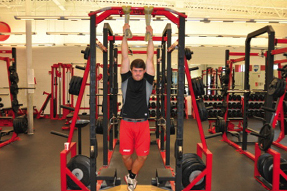
Photo 4 - Strap Pull Ups
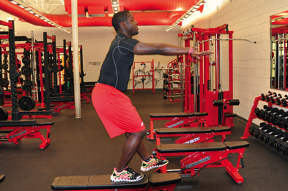
Photo 5 -Balance Squats
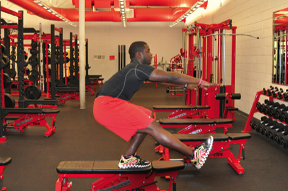
Photo 6 – Balance Squats
Bodyweight exercises help us tremendously in workouts with large groups. We are not limited by the amount of bars, racks, plates, etc. We can get a large number of athletes working at the same time because of the need for less, if any, equipment. This really comes into play with our in-season workouts because we will have one side of the ball lifting at the same time. Time is also saved because the bodyweight exercises are generally easier to teach. You are not spending valuable minutes going over how to do things. This, again, maximizes efficiency in the weight room.
Ways to Change Intensity
Like most football programs, we have a wide range of body types. Using their own body weight essentially individualizes the players’ programs for them. The most common way we handle manipulating the intensity levels is changing the rep schemes. For example, often during pull ups we will create different target reps as a goal based upon a specific group. We usually split the team into three different groups (Big - OL and DL; Big Skill - QB, RB, TE, LB, K/P; Skill - WR and DB). The big guys may have to do 25 total reps. The big skill players may do 40 reps. Skill guys could do 50 reps. Each player would do as many as possible on each set until he hits the desired total rep amount. The rest interval between each set is roughly around 20 seconds.
We can also manipulate intensity by adjusting resistance using weights (weighted vests) and dip belts. We use bands for assistance and to add resistance. A lot of our big guys use bands to assist them with pull ups or dips. Conversely, a lot of our “Skill” guys will use dip belts to add weight to pull ups or dips. They will use the bands to add resistance to push up variations (See photos 7-11). 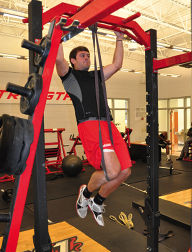
Photo 7 - Band-Assisted Pull Up
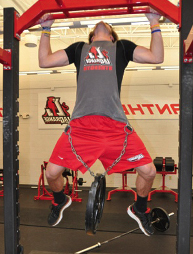
Photo 8 - Pull Up w/ Added Weight
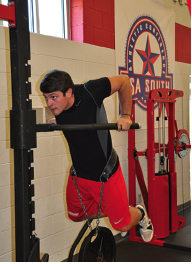
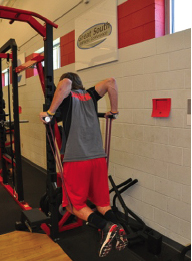
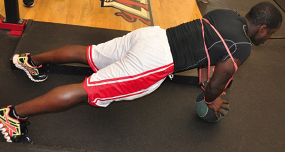
Photo 11 – Medicine Ball Push-Up w/ Band
The inverted row is a good example of the progression we use for bodyweight exercises. We can first start with our feet flat on the floor and pull ourselves up. The big guys usually stick with this one because it enables them to use some leg strength to pull themselves up. The next step in the progression is only having your heels on the floor. The concept remains the same. Only the point of the fulcrum changes. From there it gets a bit more challenging. We can move to only having one foot on the floor or adding a plate to the chest or a weighted vest (See photos 12-14).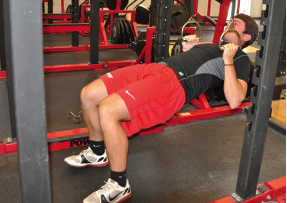
Photo 12 - Inverted Row Progression #1 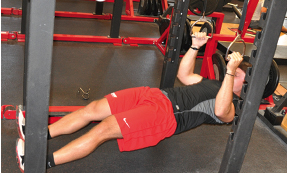
Photo 13 - Progression #2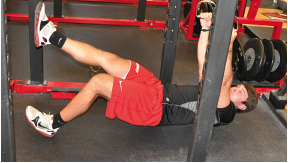
Photo 14 - Progression #3
Making It Fit
We use our bodyweight movements as key assistance exercises. Here is an example of an off-season three-day training template we have used: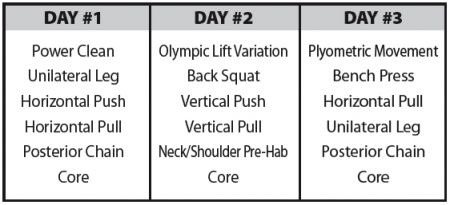
We could insert bodyweight exercises in a few different places. Typically, we would place them in any of the push/pull or unilateral leg slots. We may not include them every week, but most weeks we will have some form of bodyweight exercises in the training schedule. We rarely do any assistance exercise more than once in a four-week mini-cycle. We change constantly. Bodyweight exercises would be no exception.
Using bodyweight exercises has enabled us to include more athletic movements in our strength workouts. It has also allowed us to increase the variety of our workouts and has proven to be fun and challenging for our players. We have seen benefits on the field, in the training room, and have also been able to maximize efficiency by incorporating more of these types of exercises in our overall training schedule.
Sign Up for the Play of the Week Newsletter

STRENGTH & CONDITIONING VIDEOS

MORE X's & O's


|
Home |
Magazine |
Back Issues |
Shopping |
Subscribe |
Contact
Girdiron Strategies PO Box 14041 North Palm Beach, FL 33408 p. 561-355-5068 Copyright 2024, Gridiron Strategies a division of AFM Media, LLC. All Rights Reserved. |

Subscribe
Login
Renew
Change Address
Customer service